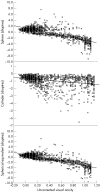Defining myopia using refractive error and uncorrected logMAR visual acuity >0.3 from 1334 Singapore school children ages 7-9 years
- PMID: 16488963
- PMCID: PMC1856974
- DOI: 10.1136/bjo.2005.079657
Defining myopia using refractive error and uncorrected logMAR visual acuity >0.3 from 1334 Singapore school children ages 7-9 years
Abstract
Aim: To determine the association of spherical equivalent (SE) with low uncorrected visual acuity (VA) along with a proposed definition for myopia using logMAR VA >0.3 as the criteria.
Methods: 1334 Chinese schoolchildren (mean age 7.8; range 7-9 years) were enrolled in the study after those who had hyperopia > or =+2.00 dioptres (D) and astigmatism > = -2.00 D were excluded. Uncorrected logMAR VA was measured for both eyes. Cycloplegia autorefraction was achieved by the instillation of three drops of 1% cyclopentolate 5 minutes apart. The average of five successful consecutive refraction and keratometry readings were obtained with calibrated Canon RK5 autokeratorefractometers by well trained optometry students, at least 30 minutes after the instillation of the third drop of cyclopentolate. SE cut-off points (-0.25 D, -0.5D, -0.75 D, -1.0 D) were evaluated.
Results: Using different SE cut-off points, the myopia prevalence rates of this sample of schoolchildren varied from 45.8% (SE at least -0.25 D) to 30.7% (SE at least -1.0 D). The cut-off point of > or =-0.75 D had a sensitivity and specificity of 91.8% (95% CI, 89.2 to 94.4) and 93.7% (95% CI, 92.1 to 95.3), respectively, to predict low vision defined as uncorrected logMAR VA > 0.3 (either eye). The next best cut-off point of -0.5D had a higher sensitivity (93.3%), but lower specificity (87.9%).
Conclusions: The cut-off points of -0.75D and -0.5D in SE refraction are appropriate for the prediction of uncorrected logMAR VA worse than 0.3, which is the criterion for the US common state adult driver licensing standard.
Similar articles
-
Visual acuity and the causes of visual loss in a population-based sample of 6-year-old Australian children.Ophthalmology. 2005 Jul;112(7):1275-82. doi: 10.1016/j.ophtha.2005.01.052. Ophthalmology. 2005. PMID: 15921756
-
Refractive error and patterns of spectacle use in 12-year-old Australian children.Ophthalmology. 2006 Sep;113(9):1567-73. doi: 10.1016/j.ophtha.2006.02.066. Epub 2006 Jul 20. Ophthalmology. 2006. PMID: 16857261
-
Use of visual acuity to screen for significant refractive errors in adolescents: is it reliable?Arch Ophthalmol. 2010 Jul;128(7):894-9. doi: 10.1001/archophthalmol.2010.134. Arch Ophthalmol. 2010. PMID: 20625052 Clinical Trial.
-
IMI - Defining and Classifying Myopia: A Proposed Set of Standards for Clinical and Epidemiologic Studies.Invest Ophthalmol Vis Sci. 2019 Feb 28;60(3):M20-M30. doi: 10.1167/iovs.18-25957. Invest Ophthalmol Vis Sci. 2019. PMID: 30817826 Free PMC article. Review.
-
Myopia among schoolchildren in East Asia and Singapore.Surv Ophthalmol. 2017 Sep-Oct;62(5):677-697. doi: 10.1016/j.survophthal.2017.03.006. Epub 2017 Mar 28. Surv Ophthalmol. 2017. PMID: 28359704 Review.
Cited by
-
Cutoff values of axial length/corneal radius ratio for determining myopia vary with age among 3-18 years old children and adolescents.Graefes Arch Clin Exp Ophthalmol. 2024 Feb;262(2):651-661. doi: 10.1007/s00417-023-06176-0. Epub 2023 Aug 14. Graefes Arch Clin Exp Ophthalmol. 2024. PMID: 37578514
-
Systematic review and meta-analysis of myopia prevalence in African school children.PLoS One. 2022 Feb 3;17(2):e0263335. doi: 10.1371/journal.pone.0263335. eCollection 2022. PLoS One. 2022. PMID: 35113922 Free PMC article.
-
Cataract surgery outcomes: comparison of the extracapsular cataract extraction and manual small incision cataract surgery techniques.Afr Health Sci. 2022 Mar;22(1):619-629. doi: 10.4314/ahs.v22i1.72. Afr Health Sci. 2022. PMID: 36032425 Free PMC article.
-
Low prevalence of myopia among school children in rural China.BMC Ophthalmol. 2018 Jun 11;18(1):140. doi: 10.1186/s12886-018-0808-0. BMC Ophthalmol. 2018. PMID: 29890943 Free PMC article.
-
The cost-effectiveness of Welcome to Medicare visual acuity screening and a possible alternative welcome to medicare eye evaluation among persons without diagnosed diabetes mellitus.Arch Ophthalmol. 2012 May;130(5):607-14. doi: 10.1001/archopthalmol.2011.1921. Arch Ophthalmol. 2012. PMID: 22232367 Free PMC article.
References
-
- Hirsch M J. The changes in refraction between the ages of 5 and 14, theoretical and practical considerations. Am J Optom Arch Am Acad Optom 195229445–459. - PubMed
Publication types
MeSH terms
LinkOut - more resources
Full Text Sources



